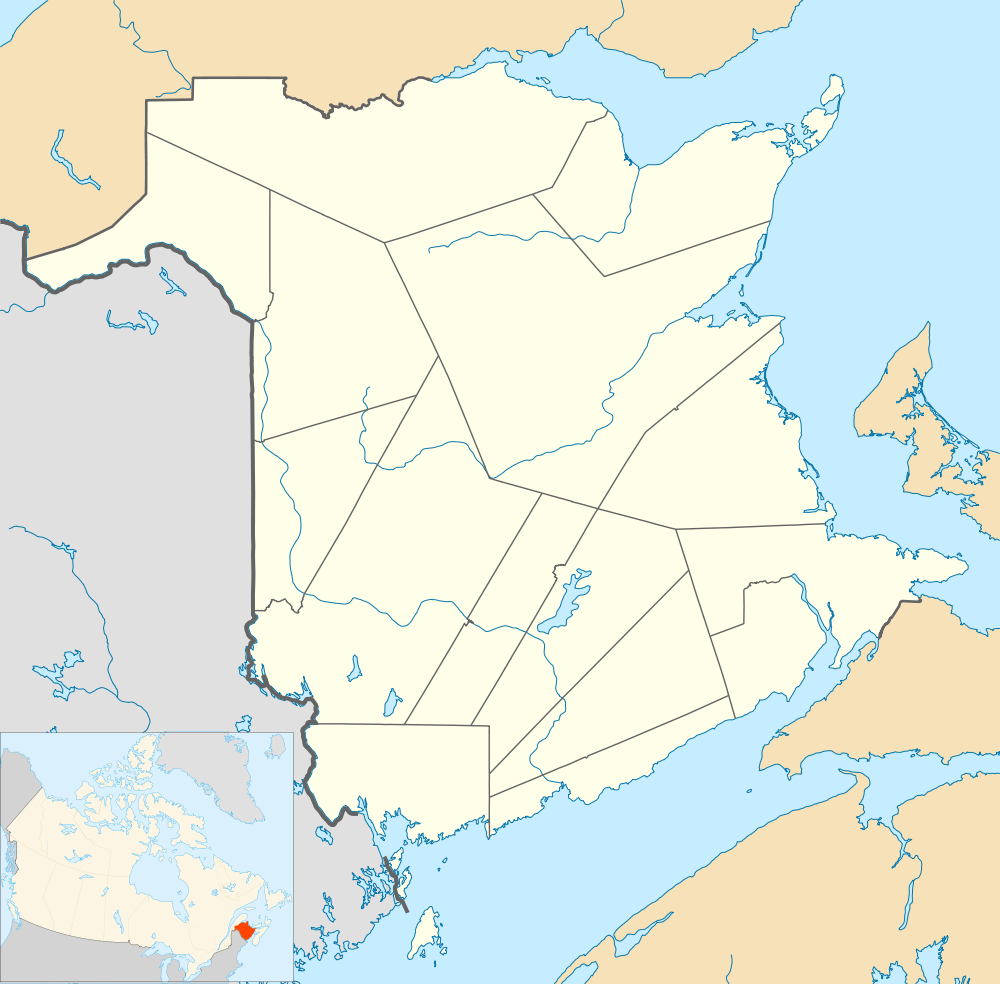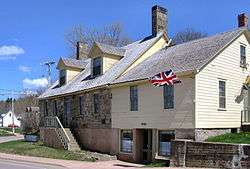Dorchester, New Brunswick
| Dorchester | |
|---|---|
| Village | |
|
The old Bell Inn in Dorchester, New Brunswick was an inn between 1820 and 1860. | |
 Dorchester Location of Dorchester, New Brunswick | |
| Coordinates: 45°54′5.6″N 64°30′57.9″W / 45.901556°N 64.516083°WCoordinates: 45°54′5.6″N 64°30′57.9″W / 45.901556°N 64.516083°W | |
| Country |
|
| Province |
|
| County | Westmorland |
| Parish | Dorchester Parish |
| Government | |
| • Type | Village council |
| • Mayor | Jerome Bear |
| • Deputy Mayor | Robert Hickman |
| Area | |
| • Land | 5.74 km2 (2.22 sq mi) |
| Population (2011) | |
| • Total | 1,167 |
| • Density | 203.3/km2 (527/sq mi) |
| • Change 2006-11 |
|
| Time zone | Atlantic (UTC-4) |
| • Summer (DST) | Atlantic (UTC-3) |
| Area code(s) | Area code 506 |
| Dwellings | 243 |
| Website | http://www.dorchester.ca/ |
Dorchester is a village and shire town in Westmorland County, New Brunswick, Canada. It is named for Guy Carleton, 1st Baron Dorchester, an 18th-century Governor-General of the old Province of Quebec.
It is located on the eastern side of the mouth of the lush Memramcook River valley near the river's discharge point into Shepody Bay. Dorchester is an English-speaking community but it is adjacent to French-speaking Acadian areas farther up the Memramcook River valley.
Economy
The village's main employer today is the Correctional Service of Canada, which operates a prison complex now comprising the medium-security (once maximum-security) Dorchester Penitentiary, and the minimum-security Westmorland Institution.
Many residents commute to work in the nearby towns of Sackville and Amherst or the cities of Moncton and Dieppe.
Tourism is centred on the historic and natural features of the area. One of Dorchester's most historic buildings houses the Keillor House Museum. The annual shorebird migration to the mud flats of nearby Johnson's Mills is celebrated by an oversize model of a semi-palmated sandpiper situated in the village square.
Transportation
Rail
Although situated on the CN Rail main line between Halifax and Montreal, Dorchester no longer has a passenger station, with travellers having to entrain/detrain in Sackville or Moncton. The nearest airport is the Greater Moncton International Airport, a 40 km drive in Dieppe.
History
The shire town of the county, Dorchester has several fine historic homes and civic buildings most of which were built by local lawyer and Master Builder, John Francis Teed. During the 19th century, Dorchester and neighbouring Dorchester Island were important shipbuilding centres. Numerous master mariners also lived in Dorchester and vicinity during the "Age of Sail". It was a centre for the stagecoach, as well as a busy ship port. The community was transformed with the construction in 1872 of the Intercolonial Railway between Halifax and Rivière-du-Loup. In 1911, the village founded the Dorchester Light and Fire Company which is currently known as the Dorchester Volunteer Fire Department. In 1965, the village courthouse was destroyed by arson. The building was never rebuilt, and much of the economy behind it left the community. Many in the community came to the town square to watch the building burn. The only thing left of the courthouse was the safe. It is now being used in the village hall, located where the courthouse once stood.
Dorchester was also home to Edward Barron Chandler, a father of confederation and his family who built their home, Chandler House, commonly referred to as Rocklynn which is now a nationally recognized historic property.
Premier Louis Robichaud's government during the 1960s created an industrial park and deepwater loading pier at nearby Dorchester Cape as part of a regional economic development program. Envisioned to be used by the petro-chemical industry, the government constructed a new road and railway spur along with an electrical substation and the pier as well as a building that was envisioned to be used as a fertilizer plant. The industrial park had no tenants and the pier sitting in the Memramcook River was quickly silted in by mud from the tides of the Bay of Fundy. Today all that remains are the roads and the railbed as well as some broken street lights, a deteriorating sea wall and the empty shell of the abandoned fertilizer plant.
In 1993, the jailhouse was also closed. It is currently a gym and storage facility.
Demographics
|
Population trend [1]
|
Religious make-up (2001)
|
Income (2006)
|
Mother tongue language (2006)
|
Notable people
- William Henry Snyder Nickerson - Dorchester born winner of the Victoria Cross for actions performed during the Second Boer War
- John F. Hickman - a Canadian soldier victim of the 1919 Kinmel Park riots in Wales after World War I, parents lived at Dorchester, he is buried at Dorchester Rural Cemetery.[2]
- Edward Barron Chandler - Edward Barron Chandler, a father of confederation and his family who built their home, Chandler House, Commonly referred to as Rocklynn later inhabited by the Teed Family.
- John Francis Teed, Master Builder - an architect and lawyer who is a "third-generation Loyalist was one of Dorchester, New Brunswick's most celebrated master builders. Teed's reputation was sealed with the construction of Mount Allison University's Centennial College Hall (1884) and Owens Art Gallery (1895). In 1895, he supervised the expansion of St. Francis Xavier University's Xavier Hall with the addition of a new two-storey west wing.[3] " He is an ancestor of the Teeds of Saint John.
See also
Trivia
- Dorchester appears fictionalized in Douglas How's humorous book Blow Up the Trumpet in the New Moon (1993).
- The song Dorchester by Matt Minglewood is about the Dorchester Penitentiary.
- Dorchester is home to the world's largest sandpiper.
- The Bell Inn Restaurant is believed to be the oldest stone building in New Brunswick (1811). It is also in the book of Where To Eat In Canada.
Bordering communities
 |
Taylor Village | Middleton | Fairfield |  |
| Beaumont | |
Cherry Burton | ||
| ||||
| | ||||
| Beaumont | Dorchester Cape | Evans |
References
- ↑ Statistics Canada: 1996, 2001, 2006 census
- ↑ CWGC Casualty record.
- ↑ http://people.stfx.ca/lstanley/history/architects.htm#Teed
- One Village, One War, 1914-1945: A Thinking About the Literature of Stone, by Douglas Howe, Hantsport: Lancelot Press (1995). The story of Dorchester residents who served Canada in World Wars I and II.
- Dorchester Island and Related Areas, by Reginald B. Bowser, 1986.
- Bill Hamilton - Historian
- Bell Inn Restaurant official website
- Village of Dorchester official website
